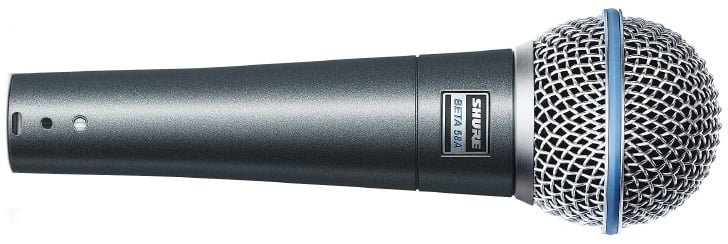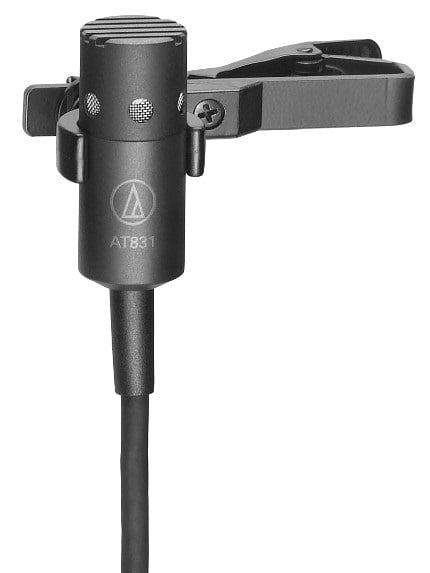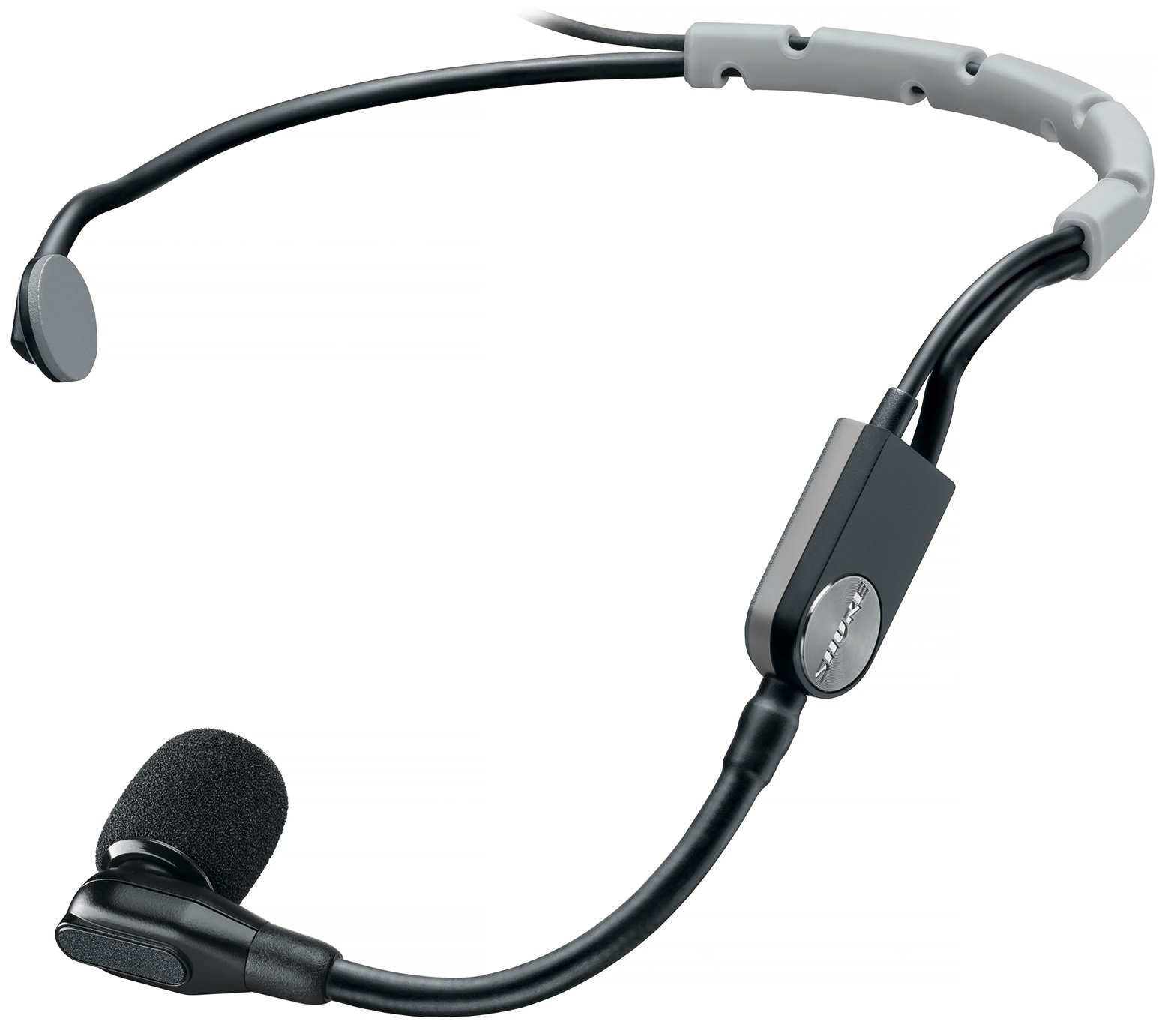As with so many aspects of sound and audio for worship, the answer is...it depends! Do you stand behind a pulpit? Prefer to move around? Do you speak softly, or have a voice that really projects? Will the mic be used primarily by one person, or multiple people during a service? And, what kind of visual do you want—should the mic be as invisible as possible, or does that not matter?
We’ll go through your various options, and explain their pros and cons. However, this isn’t always an “all or nothing” situation, because you can have more than one mic—for example, a podium mic when standing behind a podium, and a mic set up on a mic stand for other people who will be speaking during a service. (Also note that many of these same choices are faced by people doing seminars, presentations, or podcasts, so we can benefit from their experience as well in how to make the right choice.)
Your main mic options are handheld, podium, lapel, or headset Definition:
Definition:
A headphone with boom microphone for intercom, communications, learning labs, gaming, or sportscasting. mics. Each has advantages and disadvantages.
Handheld Mics
These days, more pastors like to move around as they spread the Word. Handheld mics are a great choice for mobility, and in the hands of someone with good mic technique, are almost like an instrument. If the mic is a cardioid Definition:
Definition:
A microphone's heart-shaped directional pickup pattern. type (Fig. 1)—in other words, its directional pattern picks up sounds coming from the front, while rejecting sounds from the rear—then moving closer to the mic increases the amount of bass, which can give a fuller, more intimate effect. You can also move the mic closer for a more intimate feel, especially if you want to emphasize certain phrases or ideas without shouting, and then pull away when you need to speak really forcefully. This can avoid overloading the mixer Definition:
Definition:
Combiner, controller, and router for multiple audio or video signals., and possibly causing distortion Definition:
Definition:
A change in an electronic or acoustic signal's waveform. This can undesirable if it impacts signal quality, or desirable when used for creative signal processing..

Hand-held mics often have an on-off switch and low-frequency Definition:
Definition:
A value, expressed in Hertz, that indicates how many cycles of a periodic signal occur in one second. rolloff switch. The on-off switch is very useful because if someone is moving around, accidentally gets in front of the PA Definition:
Definition:
(Public Address) A sound system intended to provide audio coverage to large groups of people. speaker, and creates a sudden burst of feedback, you can switch off the mic output momentarily while you move out of the PA’s soundfield. (The low-frequency rolloff switch is more set-and-forget; enabling it can help reduce feedback.)
Hand-held mics can be versatile as well. Sometimes holding a mic gives a good stage image, but you can also place it on a mic stand, or use a desk stand on a pulpit or podium for hands-free miking. While hand-held mics typically include a minimal pop filter Definition:
Definition:
A microphone accessory, typically made from a plastic or metal mesh, placed between a vocalist or narrator and a microphone to reduce wind noise or breath blasts. inside the microphone’s “ball,” if the person speaking is prone to “p-popping,” then you can place the mic on a stand and add a pop filter accessory.
Podium (Pulpit) Mics
Many pastors prefer standing at a pulpit over moving around, because they can concentrate on their sermon more readily. In this case, a podium mic is ideal (Fig. 2). This is typically a small mic (much smaller than a handheld model) that attaches to a flexible, movable, relatively thin stand that’s anchored to a pulpit or podium.

The important attribute here is flexibility. With a traditional mic stand, you need to re-adjust the stand height if you have a succession of speakers, some short and some tall. With the podium mic, just move the flexible gooseneck so that it’s at the same height as the speaker. Typically, you’ll also angle it a bit away from the speaker to discourage “p-popping.” The main issue—which may or may not be a disadvantage—is that the mic will almost always attach physically to the podium, so the speaker is “anchored” to the podium as well.
The Shure MX418/C Cardioid Gooseneck Mic is a particularly good choice for several reasons. One is that you can choose the directional response by choosing one of three interchangeable mic capsules. For example, if the mic is going to be a bit of a distance from the speaker, an omnidirectional Definition:
Definition:
A pattern describing a microphone, radio antenna, or loudspeaker that radiates or picks up in all directions equally. mic pickup Definition:
Definition:
1. Transducer attached to a musical instrument that converts mechanical vibrations into an electrical signal for recording or amplification 2. The part of a phonograph that translates mechanical motion from grooves into electrical signals for subsequent amplification. pattern, which picks up sound from all directions, may be best. However, if there’s the possibility of background noise or other sounds being picked up (e.g., addressing a banquet, or feedback from the PA), a directional, cardioid mic is probably a better choice. The MX418/C also includes an XLR preamp for feeding a mixer, and a shock mount Definition:
Definition:
A device to isolate a microphone from external mechanical vibrations. In housings, isolation from external vibration and shocks. that reduces the possibility of vibrations being transmitted from the floor and up into the pulpit, which could cause low-frequency rumbles.
Lapel (Lavalier) Mics
These miniature mics get their name because they usually clip on to someone’s lapel. They’re unobtrusive, and have thin wires that can be routed out of sight, like under someone’s shirt and out their back. With wireless mics, the mic output can terminate in a belt pack Definition:
Definition:
A portable, body-worn device, often an intercom, wireless mic, or listening device. It gets its name because they is often a clip for making a secure attachment to a belt. that can go on the person’s back, which keeps it out of sight (Fig. 3).

The big advantage of using a lavalier mic is not drawing attention to the microphone (this is often crucial when video is involved). However, there are some challenges. First, a lapel is not necessarily the optimum position to mic up a voice (especially compared to a handheld or headset mic, which can be close to the person’s mouth). Second, if someone is talking softly, and you need to increase the gain, then feedback becomes more likely, as does leakage from other sounds. This is one reason why lapel mics are rarely used for musical performances. Finally, it’s best if the person doesn’t move around too much. The wire can pull at the mic, and if not attached well to the label, the mic can fall off—and retrieving a mic that fell behind a shirt, and finds itself lodged near someone’s bellybutton, can lead to (ahem) awkward moments.
That said, there are times when the mic needs to stay out of the picture, especially when video or projections to video screens or walls are a factor. Audio-Technica’s AT831B Cardioid Condenser Lavalier Mic has several features that make it well-suited to worship applications. It's cardioid pickup pattern reduces ambient Definition:
Definition:
- Something in a close vicinity.
- The natural sound of a space, or simulation of being in that space.
noise and increases sound isolation, which is important if the mic is more than a few inches away from the person doing the speaking. This mic also uses a condenser Definition:
Definition:
An archaic term for Capacitor. mic element, which tends to give a crisper sound than dynamic mics, and can run off battery power or a mixer’s 48V phantom power Definition:
Definition:
A source of power for a microphone (usually condenser) that travels to the microphone over the microphone's cable. There are different voltage standards and requirements for different microphones, but the most common standard is 48 Volts. It derives its name because there is no visible power cable. line. It includes a 6' cable to go to the companion power pack, which can mount on a belt.
Headset Mics
These are like the mics you use at a computer, where a band goes around your head (or takes a more minimalist approach and wraps over your ear), and the mic is on a small, bendable boom Definition:
Definition:
A vertical stand or tree on which horizontal boom arm is attached, also handheld microphone (fishpole) arm for overhead recording. that goes in front of your mouth. The main advantage is the mic will always be picking up what you say, whether you turn your head, look down, or look up. It’s also less likely to become dislodged compared to a lapel mic, and leaves your hands free compared to a handheld mic. The Shure SM35-XLR Headworn Performance Mic (Fig. 4) is a great example of this kind of mic.

There are only two significant limitations, which may not matter. The first is that the mic is always a constant distance from the speaker. The upside is that this leads to consistent, manageable levels—but there’s a downside if the person alternates between shouting and whispering. The second is that the look may be a little too “Star Trek” for some people. In some ways, it’s the most obtrusive of all the mic types, because it’s always attached to the person’s head. However, given the sonic clarity and consistency, this type of mic can offer, sometimes the visuals simply don’t matter when you consider the benefits.
Conclusions
The bottom line is there’s no lack of options! For a traditional pulpit situation, the podium mic is the logical choice—it’s small, flexible, doesn’t draw much attention to itself, and accommodates people of different heights easily. When you want the mic to disappear visually into the background, the lapel mic gets the nod; but remember that it works best with someone in a stationary position.
The handheld mic is a time-tested pick for those who like to move around, but you either need to hold on to it, or place it on a mic stand (although the latter kind of negates the ability to move around) if you need to keep both hands free. So many pastors use their hands expressively, that a headset mic might be their best choice.
And as mentioned at the beginning, you’re not limited to using only one mic. A common situation is a mic on the pulpit, with a handheld mic available if needed. So think about what you need to do, how you want to communicate your message, the visuals inherent in using a particular mic, and above all, what’s most comfortable for you to use—and that should narrow your choices down to where it will be easy to make a decision. And of course, Full Compass is committed to helping you make the best choice if you have questions.



